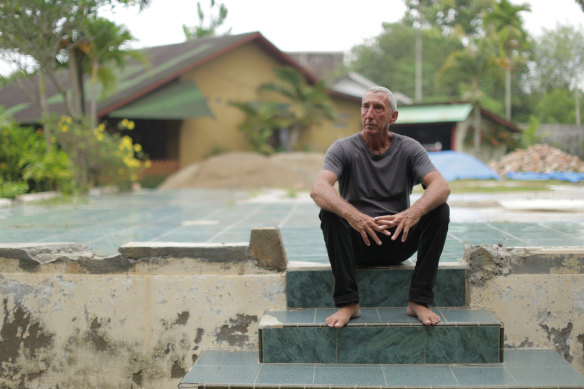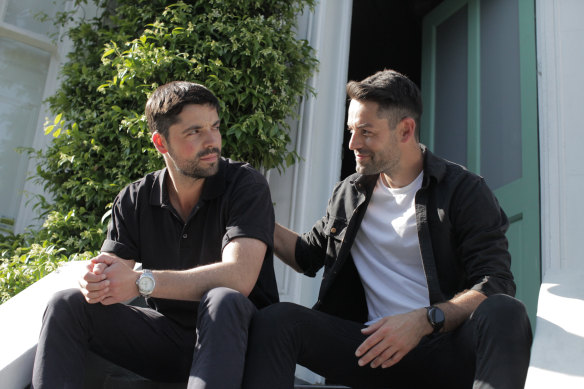This was published 4 months ago
Two decades on, survivors reflect on Boxing Day tsunami in new doco
By Jacqueline Cutler
It was a wave like no other. The Indian Ocean tsunami claimed 225,000 lives as it crashed over 14 countries. It shot forth with energy equivalent to 23,000 Hiroshima bombs.
These numbers, while important to understanding the catastrophe, may take a while to grasp. What’s more immediate and haunting are the tears of a mother crying as she remembers holding her baby tight until the raging water ripped him away.

Surfer David Lines reflects on the loss and devastation of the 2004 Indian Ocean tsunami.Credit: National Geographic / Duane McClunie / Richard Ing
Survivors of the Boxing Day tsunami, 20 years ago, recount their stories in Tsunami: Race Against Time. It’s not easy watching, but by personalising the century’s deadliest natural disaster, the documentary puts it in context. It also highlights the lack of warning systems then, which has since been ameliorated.
“My instinct when I joined was, well, let me look at the archive,” says director Daniel Bogado. “You don’t need anything else. You just need the archive and the old testimony. Anything else is counterproductive because it’s getting in the way of stuff that’s extraordinary.”
Bogado says the production cut the material as though they were editing a film. “In a film, if an explosion happens, you don’t go back and see it from another angle. You don’t stop for the narrator to say something,” he says. “It’s not like being in a class lesson. It’s like being in a film, and a film is in real time, and it’s immersive.
“And if we do that, and then we see somebody on camera, but then we start hearing their thoughts, and then we cut to them, and they are telling us exactly what they were thinking. At that moment, you’ll feel like you were there.”

Brothers Theo and Louis Mullan were on holiday with their parents in Khao Lak, Thailand, when the 2004 tsunami hit.Credit: National Geographic / Charlie Laing / Alec Davy
It was no place anyone wanted to be when it happened. The destruction ravaged islands that were paradises. Brackish water carried people, boats, houses and trucks. Anything it rushed over, it consumed.
Admittedly, there’s no shortage of documentaries about the waves that never stopped coming. This, though, tracks the wave’s roughly 12-hour path as it made its way off the coast of Sumatra, Indonesia, at 7.58am, following a 9.2-magnitude earthquake, the third most powerful temblor ever recorded. Waves swelled to more than 30 metres high.
The film debunks the commonly held notion that it was one giant wave. There was often more than one. Graphics illustrate how it swelled through the ocean and how they hit land. Typically, blue water turned black and ominous as it swept ashore.
As relentlessly tragic as the tsunami was, the film shines a light on the goodness of people, of strangers helping one another.
The four-part series shares a sensibility with 9/11: One Day in America, the Emmy-winning doco series Bogado directed. Both show how a lack of communication costs lives, and they highlight the better nature of humans.
That series also relied on archives and sharp reporting. By going to TV stations in the areas hit by the tsunami, Bogado and his team found footage that guided their story. They then found people who had survived against all odds.
Bogado acknowledges that this approach works for chronicling very specific global events which trigger a tremendous amount of footage. Timing, too, is critical.
“Twenty years is the perfect amount of time because it’s enough that people had time to process it, and they look at it as something in their past,” he says. “But it’s not so much that everybody who was alive will no longer be there.”
Still, no one wants disaster porn. Why use misery as a diversion? It’s too easy to focus only on flattened towns, roads washed away, lives shattered. Rather, Bogado felt an imperative to tell this story.
“I always think that these kinds of projects need to have a moral purpose,” he says. “They need to be a force for good in the world. And with something like these big tragedies, I think there’s a lot of wisdom, hard-earned wisdom from the survivors, from people who have been so close, or who’ve lost people, or who became very close to dying themselves.
“What they felt they learnt from that, right? And often, the lesson about the last people they were thinking about were their loved ones. And so that means that it changes the way they behave onwards. The same thing happened with 9/11. People would say it was extraordinary how people came together.”
A psychiatrist on holiday was drafted into triaging the injured. Those strong enough to help carried the bleeding, others searched for the missing. The doco reveals reunions destined to make even the most black-hearted mist up as brothers find each other in the soggy rubble. Still, 225,000 people died.
“It serves to remember the people that were lost and to honour them,” Bogado says. “That’s the first thing; the second part is the historical record. It is extraordinary how we live in times where we can document everything, and then when you try to track it down, you realise so much has already been lost. The third is this exploration of the human condition. I think, when people are able to follow these stories, step by step, it is profoundly affecting.”
As terrifying and disastrous as the tsunami was, the documentary’s overarching message is “about people coming together, about what a wonderful force that can be”, he says.
“The documentary itself, the making of it, is about people coming together too,” Bogado says. “Because we had people, teams of researchers and producers in Indonesia, Thailand, India and Sri Lanka, incredibly passionate, incredibly smart, tenacious and dedicated people. We wouldn’t have been able to make the films without them – many of them either survivors of the tsunami themselves or lost relatives during this.
“They’re very, very good at what they do,” Bogado adds. “And everybody comes together, and we create this thing that hopefully inspires other people. So, it works at both levels, even in the creation of it. The message of the series is embedded even in its creation.”
Tsunami: Race Against Time screens on Disney+ from November 25.
Find out the next TV, streaming series and movies to add to your must-sees. Get The Watchlist delivered every Thursday.